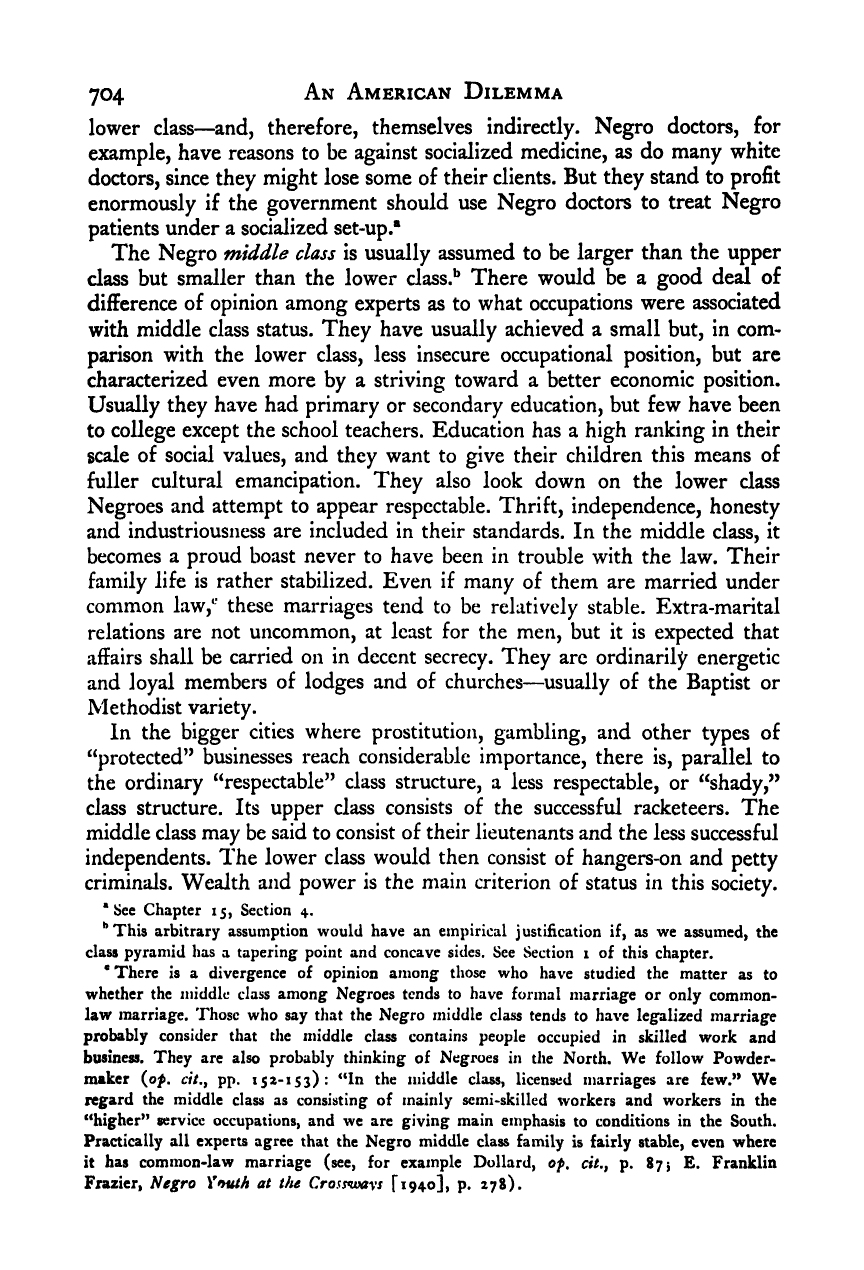Note: Gunnar Myrdal died in 1987, less than 70 years ago. Therefore, this work is protected by copyright, restricting your legal rights to reproduce it. However, you are welcome to view it on screen, as you do now. Read more about copyright.
Full resolution (TIFF) - On this page / på denna sida - VIII. Social Stratification - 32. The Negro Class Structure - 4. The Classes in the Negro Community

<< prev. page << föreg. sida << >> nästa sida >> next page >>
Below is the raw OCR text
from the above scanned image.
Do you see an error? Proofread the page now!
Här nedan syns maskintolkade texten från faksimilbilden ovan.
Ser du något fel? Korrekturläs sidan nu!
This page has never been proofread. / Denna sida har aldrig korrekturlästs.
704 An American Dilemma
lower class—and, therefore, themselves indirectly. Negro doctors, for
example, have reasons to be against socialized medicine, as do many white
doctors, since they might lose some of their clients. But they stand to profit
enormously if the government should use Negro doctors to treat Negro
patients under a socialized set-up.*
The Negro middle class is usually assumed to be larger than the upper
class but smaller than the lower class.** There would be a good de^ of
difference of opinion among experts as to what occupations were associated
with middle class status. They have usually achieved a small but, in com-
parison with the lower class, less insecure occupational position, but are
characterized even more by a striving toward a better economic position.
Usually they have had primary or secondary education, but few have been
to college except the school teachers. Education has a high ranking in their
scale of social values, and they want to give their children this means of
fuller cultural emancipation. They also look down on the lower class
Negroes and attempt to appear respectable. Thrift, independence, honesty
and industriousness are included in their standards. In the middle class, it
becomes a proud boast never to have been in trouble with the law. Their
family life is rather stabilized. Even if many of them are married under
common law,*’ these marriages tend to be relatively stable. Extra-marital
relations are not uncommon, at least for the men, but it is expected that
affairs shall be carried on in decent secrecy. They arc ordinarily energetic
and loyal members of lodges and of churches—usually of the Baptist or
Methodist variety.
In the bigger cities where prostitution, gambling, and other types of
“protected’’ businesses reach considerable importance, there is, parallel to
the ordinary “respectable” class structure, a less respectable, or “shady,”
class structure. Its upper class consists of the successful racketeers. The
middle class may be said to consist of their lieutenants and the less successful
independents. The lower class would then consist of hangers-on and petty
criminals. Wealth and power is the main criterion of status in this society.
•See Chapter 15, Section 4,
‘’This arbitrary assumption would have an empirical justification if, as we assumed, the
class pyramid has a tapering point and concave sides. See Section 1 of this chapter.
* There is a divergence of opinion among those who have studied the matter as to
whether the middle class among Negroes tends to have formal marriage or only common-
law marriage. Those who say that the Negro middle class tends to have legalized marriage
probably consider that the middle class contains people occupied in skilled work and
business. They are also probably thinking of Negroes in the North. We follow Powder-
maker (o^. ch.y pp. 152-153): “In the middle class, licensed marriages are few.” We
regard the middle class as consisting of mainly semi-skilled workers and workers in the
“higher” service occupations, and we are giving main emphasis to conditions in the South.
Practically all experts agree that the Negro middle class family is fairly stable, even where
it has common-law marriage (see, for example Dollard, op, cit., p. 87 j
E. Franklin
Frazier, Negro Youth at the Cro^svsxys [1940], p. 278).
<< prev. page << föreg. sida << >> nästa sida >> next page >>